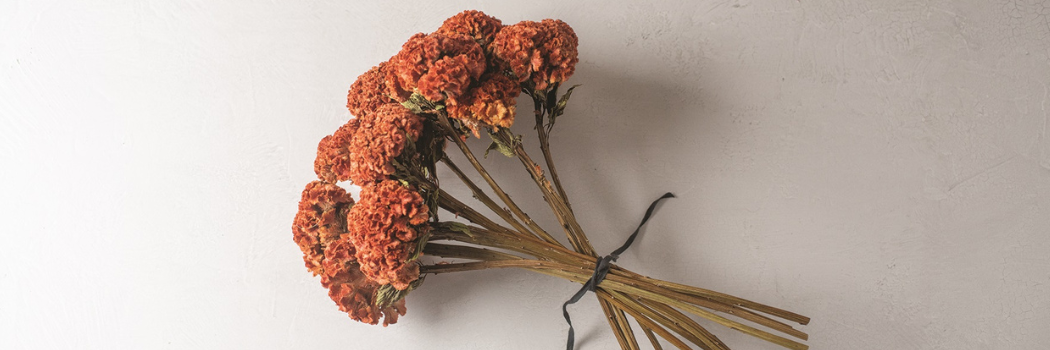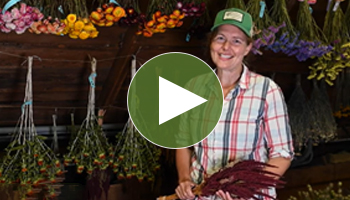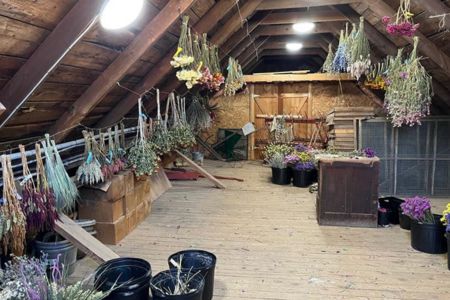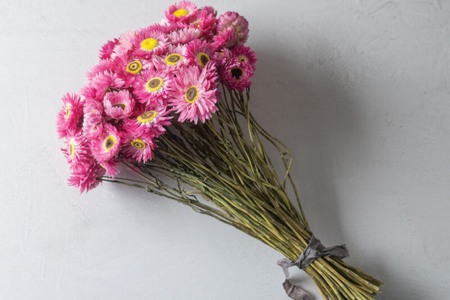- Modern Everlastings: Guidance on Dried Botanicals from 4 Far-flung Farmer-Florists
- Video: Tips & Recommendations for Dried Flowers • Tutorial with Joy Longfellow
- How to Air-Dry Cut Flowers | Easy Instructions from Johnny's
- Beyond Blossoms | Expanding & Diversifying Your Dried Floral Menu
- Video: Savannah Grass (Melinus nerviglumis) for Cut-flower Production | from Johnny's Selected Seeds
- Ammobium | Key Growing Information
- Artemisia (Sweet Annie) | Key Growing Information
- Artichokes | Key Growing Information
- Atriplex hortensis | Key Growing Information
- Bells of Ireland (Moluccella laevis) | Key Growing Information
- Black Tip & Silver Tip Wheat | Key Growing Information
- Greater Quaking Grass (Briza maxima) | Key Growing Information
- Bupleurum | Key Growing Information
- Cardoon | Key Growing Information
- Carthamus (Safflower) | Key Growing Information
- Celosia (Cockscomb, Cristata, Spicata) | Key Growing Information
- Roman Chamomile | Key Growing Information
- Northern Sea Oats | Key Growing Information
- Broom Corn (Sorghum bicolor) | Key Growing Information
- Ornamental & Dry Field Corn (Zea mays) | Key Growing Information
- Craspedia (Drumstick Flower, Billy Buttons) | Key Growing Information
- Dill | Key Growing Information
- Dusty Miller | Key Growing Information
- Echinacea (Coneflower) | Key Growing Information
- Echinops (Globe Thistle) | Key Growing Information
- Eragrostis tef | Key Growing Information
- Eryngium (Sea Holly, Eryngo) | Key Growing Information
- Eucalyptus | Key Growing Information
- Gomphrena (Globe Amaranth) | Key Growing Information
- Hare's Tail Grass | Key Growing Information
- Helipterum (Paper Daisy / Rhodanthe) | Key Growing Information
- Larkspur | Key Growing Information
- Lavender | Key Growing Information
- Sweet Marjoram | Key Growing Information
- Matricaria (Feverfew) | Key Growing Information
- Savannah Grass (Melinis nerviglumis) | Key Growing Information
- Monarda (Bee Balm: M. didyma & M. citriodora) | Key Growing Information
- Mountain Mint | Key Growing Information
- Nigella | Key Growing Information
- Oregano (Greek) | Key Growing Information
- Ornamental Basil | Key Growing Information
- Ornamental Gourds | Key Growing Information
- Ornamental Kale | Key Growing Information
- 'Frosted Explosion' Ornamental Grass | Key Growing Information
- 'Green Drops' Ornamental Panic Grass | Key Growing Information
- Ornamental Pearl Millet (Cenchrus americanus) | Key Growing Information
- Feathertop Grass (Cenchrus longisetus) | Key Growing Information
- Persian (Ornamental) Cress | Key Growing Information
- Rosemary | Key Growing Information
- Rudbeckia hirta | Key Growing Information
- Common Sage (Salvia officinalis) | Key Growing Information
- Salvia farinacea (Mealycup Sage) | Key Growing Information
- Salvia viridis (Annual Clary Sage) | Key Growing Information
- Scabiosa spp. (Pincushion Flower) | Key Growing Information
- Foxtail Millet (Setaria italica) | Key Growing Information
- Spilanthes | Key Growing Information
- Statice | Key Growing Information
- Strawflower | Key Growing Information
- Summer Savory | Key Growing Information
- Talinum paniculatum (Jewels of Opar) | Key Growing Information
- Tall (Single Stem) Sunflowers | Key Growing Information
- Thyme | Key Growing Information
- White Sage | Key Growing Information
- Wild Marjoram | Key Growing Information
- Winter Savory (Satureja montana) | Key Growing Information
- Xeranthemum (Paper Flower, Immortelle) | Key Growing Information
- Yarrow | Key Growing Information
- Video: Gomphrena Types & Tips | from Johnny's Selected Seeds
- Video: Harvesting Strawflowers for Use as Dried Flowers | from Johnny's Selected Seeds
- Video: Carthamus (Safflower) for Cut-Flower Production | from Johnny's Selected Seeds
How to Dry Flowers: Simple Instructions for Air Drying
Drying Cut Flowers & Ornamental Grasses
Often, we overlook that the vibrant colors from the height of harvest season can be preserved and enjoyed year-round. One of the easiest, thus earliest developed and still most commonly used method for preserving flowers is air-drying.
If you're interested in drying your own flowers, you likely already have all of the materials on hand, and have some place to do the drying. You may even have appropriate flowers growing in your own or nearby fields or garden beds.
Here are some how-to tips, along with some usage and merchandising ideas for preserving the colors of summer, to brighten indoor spaces as the fall and winter months close in around us.
Selecting a drying space
The ideal location for air drying flowers has 3 characteristics:
- Dry. The less moisture in the air, the better.
- Well-ventilated. Moving air helps prevent moisture from settling and mold from developing on the plant tissues.
- Dark. Attics of garages, barns, and houses can be choice locations for drying flowers as most lack windows—while not crucial to the effectiveness of drying, a dark location allows the flower to better retain most of its fresh color, and prevents fading. (Alternatively, sun bleaching—intentionally allowing the flowers to achieve that "sun-kissed" look while drying—is sometimes used for autumnal arrangements with grasses, grains, and thin-stemmed flowers.)
You also need something to hang the flowers from. If you are drying only a small amount—a bouquet or two—a couple of hooks to hang the flowers from will suffice. But for drying larger quantities of flowers, stretch a strong wire or two between the rafters to serve as drying lines, in a set-up similar to a clothesline.
Choosing flowers for drying
Some flowers dry better than others:
- Plants with high water content, such as peonies, generally do not dry as well as those with low or moderate moisture volume.
- Delicate flowers, too, such as carnations, are more difficult to air dry than those made of sterner stuff.
To ensure success, select the species and varieties noted for their suitability to this purpose. Some of the classic flower crops for drying include:
- Statice
- Celosia
- Ammobium
- Gomphrena
- Helipterum (Rhodanthe spp, or paper daisy)
- For foliage and fillers, the Ornamental grasses
For ways to expand your floral menu, see our article Beyond Blossoms.
To help you easily identify the range of appropriate varieties on our website and in our catalog, we've designated appropriate flowers, grasses, herbs, and other types of suitable material with the Ideal for Drying & Crafts symbol.
When to cut
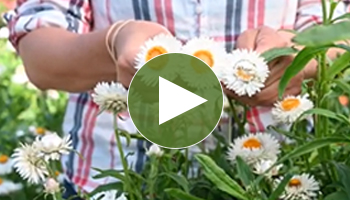
Strawflowers can be tricky because they will open and close every day. Watch our video to learn how to tell when the blooms are at the right stage for drying.
Stage
Once you have your preferred flowers planted and blooming, you will want to know which stage of growth is best for cutting.
- Whereas many flowers cut for fresh bouquets are harvested when only a few buds are opened, flowers that are cut for the purpose of drying should be almost fully bloomed. In the weeks when they are drying, the flowers will continue to open, but only slightly.
- There are exceptions, however, so be sure to read the harvest information on the product's webpage or on the back of the seed package.
- For all flowers intended for drying, harvest before the flowers set seeds.
- In addition, mature or over-mature flowers shed pollen, which can make quite a mess, or their petals, leaving you with a bloomless stem.
Time of day
- Early morning is the best time to harvest. Since the idea is to dry the flowers, however, you will want to wait until the dew has evaporated. Otherwise, it will take longer for the flowers to dry and increase the likelihood of mold developing.
- As with fresh flowers, cutting in the heat of the day can cause the flowers to wilt. Even in the cool of the evening, the plants may still be recovering from the heat and not at peak quality.
How to Dry Flowers, Step-by-Step
Cut flowers & strip leaves.
- Cut the stems long enough to bundle, but also keep in mind the desired final look—long stems for tall vases, short stems for boutonnières.
- Strip the leaves while still in the field. Stripping the leaves facilitates quicker drying and results in a cleaner end product.
Place upright.
- Place the stems upright in a bucket or other container for ease of carrying large quantities of flowers out of the fields.
- For many varieties, straight stems are the most desirable, but there are exceptions.
- Check the cultural information on the product webpage or the seed packet back for drying instructions by species.
-
Gather in small bunches.
- Gather the flowers into small bunches. Bunches with too many stems prolongs drying time due to less exposed surface area.
- Dry flowers of the same species or variety together or mixed with others. You can build your bouquets, or what have you, either before or after drying is complete.
- Stems and blooms contract as they dry, which can leave spaces in your arrangement if you build the bouquets beforehand.
Secure stems.
- Secure the stems together with a rubber band, string, twine, wire, or unscented dental floss.
- Rubber bands work well because as the stems dry down they shrink, and rubber bands keep them secure.
- If you use one of the other options, tie them with a slip knot, which will tighten on its own.
Hang.
- Hang upside-down on hooks or a wire using paper clips, florist wire, or twist ties.
- Hanging upside-down helps keep the stems straight.
- When hanging bunches on hooks or wire, allow adequate space for air movement between them—remember, good ventilation is key.
- Exceptions: Not all flowers should be hung upside down to dry, and maybe you'd prefer to have some blooms without straight stems.
- Trailing amaranthus varieties 'Emerald Tassels' and 'Love-Lies-Bleeding' are attractive when dried and displayed gracefully drooping toward the floor.
- Allowing other species to dry upright in a vase, and eventually arching, provides dimension to dried-flower arrangements.
Wait!
- Flowers will dry in approximately 1 month. Drying time varies with size of flowers and stems. When the time is right, the stems and flowers will feel rigid.
- Drying time can be decreased by higher temperatures in your drying location, and by increasing air movement, by using either natural airflow or fans.
Dried flower care • Avoiding problems
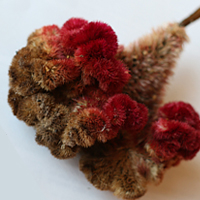
Sun bleaching and mold, as shown on this celosia, cause flowers to lose their peak colors in the drying process.
Dried flowers are relatively problem-free. We've already discussed how the sun can bleach out the color and too much moisture can encourage mold, and how to avoid these conditions.
Another concern is dust collecting on the flowers. Due to the semi-delicate nature of dried flowers, they cannot be easily dusted off with a cleaner and a cloth. For long-term storage, box them them up in tissue paper when they are dry to store them until ready to use.
Some flowers, such as strawflowers, have extremely delicate or brittle stems when dried, and many people will cut the stem right off of these after harvest and run some floral wire through the inflorescence instead, for ease of bunching in the future.
Dried flowers can be kept and stored for up to a year, beyond which their quality deteriorates, with dust or faded colors, in most cases.

Celosia blooms in a variety of heights, interesting shapes, and all the familiar colors of fall, which make them perfect for dried autumnal arrangements. Shown here is a mix of colors of the subgroup of Celosia argentea var. cristata that produces flowerheads with a tactile brain appearance and feel.
Uses for Dried Florals
As winter growing and season extension practices become more widespread among growers, so too has year-round demand for locally-grown produce. Like other value-added products, dried flowers take winter CSA shares and indoor farmers' market displays beyond vegetables. Think of dried florals as another type of valuable storage crop that needs proper care before being brought to market.
The most common use for dried flowers is to gather than into long-lasting arrangements. Good design is always appreciated, and if the flowers are kept from light while drying, the colors of the blooms will brighten indoor spaces for months to come—a welcome sight in the depths of winter. Disassemble the bunches you dried earlier, and build your arrangements by choosing the components that please you and your customers the most. Secure the stems and embellish as desired.
Seasonal and holiday décor is one of the quintessential outlets for dried flowers. Celosia blooms in all the classic warm fall tones, so they are perfect for Thanksgiving centerpieces. In a month's time, people look toward changing their November decorations for those of the winter holidays—Christmas, Hanukkah, Kwanzaa, Yuletide, New Year's Eve. In addition to bouquet arrangements, evergreen wreathes, roping, and swags adorned with dried flowers provide forms for decoration, even wreaths made entirely of dried flowers.
More ideas
- Small hand bouquets can be well-appreciated as delicate gifts for family and close friends, too. They can also be designed as fragrant Valentine nosegays.
- In recent years, winter weddings have become increasingly popular. For parties conscious of the environmental footprint of flowers imported from other continents or hemispheres, dried flowers can provide an alternative. Brides and planners can speak with a grower well in advance of the wedding date—the flowers can be planted, grown, and dried according to specifications in time for the wedding. Furthermore, the bouquet, boutonnières, and any flowers used to decorate ceremonial and reception spaces can all be dried, and kept for more lasting reflection of the big day.
- Some edible flowers, and certainly herbs, are suitable for drying and use at a later date.
- Add a floral note to tea with dried flowers.
- Potpourri made with premium-quality ingredients is both fragrant and beautiful.
- Some dried flowers can be used for natural dyes.
For more ideas on diversifying and expanding your floral menu, see our article, 'Beyond Blossoms'.
Off-season cottage industry
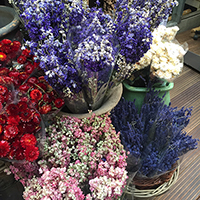
September display of dried flowers at a public market in Amsterdam.
When fall frosts hang in the air and you're rushing to protect and harvest as many vegetables as you can, don't forget your flowers. You worked hard to keep them flourishing throughout the summer. By cutting and drying them, you can get the most out of your blooms, allowing the vibrant beauty of dried flowers to brighten the winter months.
As the local flower industry takes off, there are many great opportunities for avid flower gardeners and farmers in this niche. And for vegetable growers just looking to get into flowers, this may be a good place to begin. Pairing dried florals with a creative flair could develop into a rewarding cottage industry.


